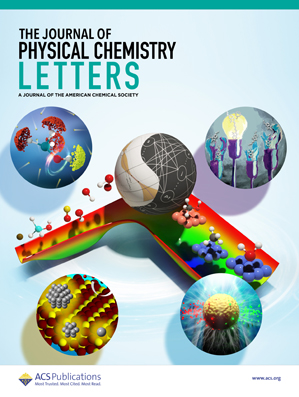醋酸在乙腈中的正、反异构体及费米共振。
IF 4.8
2区 化学
Q2 CHEMISTRY, PHYSICAL
引用次数: 0
摘要
醋酸在低温稀有气体基质中以正异构体和反异构体存在。然而,在非质子乙腈中,其在C = O拉伸区的红外光谱表现出多波段特征,这是传统FTIR光谱不能清楚理解的。在这方面,二维红外(2D IR)光谱被应用于更深入地了解起源。偏振相关的二维红外研究表明,光谱形状主要受顺式和反式异构体共存以及每个异构体中C = O拉伸和CH3摇摆泛音之间的费米共振的影响。二维红外数值模拟使用局部模式哈密顿模型,其中包含费米共振,但不假设弱或强耦合极限,准确地再现了实验结果。模拟结果表明,在22°C时,正异构体和反异构体的相对居群分别为0.935和0.065。此外,模拟量化了同型异构体-13.5 cm-1和反异构体-10.5 cm-1的费米耦合,以及相关振动态的能级。一项对氘化乙酸的时间依赖性二维红外研究表明,这两种异构体形式在10 ps的时间尺度上不交换。此外,在浓度超过20 mM时,聚集会产生额外的峰。本文章由计算机程序翻译,如有差异,请以英文原文为准。
syn- and anti-Isomers and Fermi Resonance of Acetic Acid in Acetonitrile Revealed by 2D IR.
Acetic acid exists as syn- and anti-isomers in a low-temperature rare-gas matrix. However, in aprotic acetonitrile, its IR spectrum in the C═O stretch region exhibits a multiple-band feature, which is not clearly understood by conventional FTIR spectroscopy. In this regard, two-dimensional infrared (2D IR) spectroscopy is applied to understand the origin more deeply. Polarization-dependent 2D IR studies reveal that the spectral shape is primarily influenced by the coexistence of syn- and anti-isomers, along with Fermi resonance between the C═O stretch and the CH3 rocking overtone in each isomer. Numerical 2D IR simulations using a local-mode Hamiltonian model, which incorporates Fermi resonance but does not assume either weak or strong coupling limits, accurately reproduce the experimental results. The simulations determine the relative populations of the syn- and anti-isomers at 22 °C to be 0.935 and 0.065, respectively. Additionally, the simulations quantify the Fermi coupling of -13.5 cm-1 for the syn-isomer and -10.5 cm-1 for the anti-isomer, as well as the energy levels of the associated vibrational states. A time-dependent 2D IR study of deuterated acetic acid suggests that the two isomeric forms do not exchange on the time scale of 10 ps. Besides, aggregation causes an additional peak at concentrations above 20 mM.
求助全文
通过发布文献求助,成功后即可免费获取论文全文。
去求助
来源期刊

The Journal of Physical Chemistry Letters
CHEMISTRY, PHYSICAL-NANOSCIENCE & NANOTECHNOLOGY
CiteScore
9.60
自引率
7.00%
发文量
1519
审稿时长
1.6 months
期刊介绍:
The Journal of Physical Chemistry (JPC) Letters is devoted to reporting new and original experimental and theoretical basic research of interest to physical chemists, biophysical chemists, chemical physicists, physicists, material scientists, and engineers. An important criterion for acceptance is that the paper reports a significant scientific advance and/or physical insight such that rapid publication is essential. Two issues of JPC Letters are published each month.
 求助内容:
求助内容: 应助结果提醒方式:
应助结果提醒方式:


